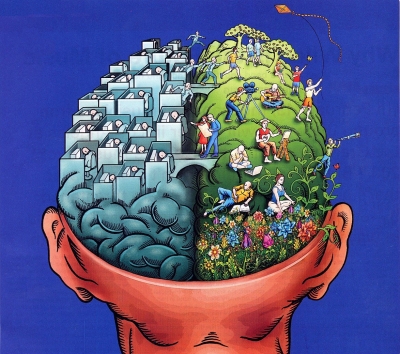Relative to body size, the human brain is one of the largest among all living creatures. This is just not in size but in function as well. Conventional wisdom and general knowledge regarding sides of the brain states that artists and writers are right brained because they are creative, and computer wizards and accountants are left brained because they are analytical. However this is not entirely correct. Many of the world’s great artists and musicians are highly left brained. This is because fine art and playing music require you to follow a pattern that has already been created.
The Brain
You may be aware that your brain is divided into two hemispheres and has a connector between them (Corpus Callosum) that lets each hemisphere work together. The two sides of the brain are anatomically and functionally separate from each other. Some might even say that the two sides of the brain have their own distinct personalities, ‘a mind of its own’.
The sophistication of the human brain allows it to be equipped with many specific functions for different duties, which either resides in the left side or the right side. This means each side of the brain does half of the whole job. Therefore in order to live a balanced, meaningful, and creative life, full of connected relationships, it is crucial that our two sides work together in harmony and be synchronised. This way the individual can value both the logic of their brain (left) and the emotions (right).
Most people think that we are born with a fully developed brain. However, from the moment we start growing in the womb, to the moment of birth, and then up to the age of two, brain development is concentrated on the right. This is the vulnerable period of time for the brain, as we are very susceptible to some of the negative impacts from our environment. Anything that interferes with prenatal development, the birthing process or healthy growth during those first two years will impact the right brain growth. This could be one of the reasons why there is a majority of right brain deficiency compared to left.
The Right Side
The right brain is the holistic and nonverbal side. It sees the big picture of the world, not just the parts. It can see the forest but not the trees, so to speak. It reads and interprets facial expressions, eye contact, tone of voice, posture, and gestures. The right is the social communicator.
Because the right is nonverbal, it learns from a subconscious or subliminal point of view. It specialises in emotions, images and personal memories. That ‘gut feeling’ comes from our right side. It is the intuitive and emotional side of our brain.
The right brain also takes charge of the big muscles of the body; the ones that control posture and gait. It is the spatial side of the brain. It controls balance and what is known as proprioception – the body’s ability to know where it is in relation to gravity and to others.
This side of the brain is responsible for the body’s immune system as it inhibits and prevents the body from overreacting to foreign invaders. So its job is to control the amount of antibodies being produced and also regulate our automatic functions, such as digestion.
The Left Side
Your left brain on the other hand loves and desires order. It loves the L words; logical, literal, linguistic (it likes words) and linear (order and lists). This side of the brain sees the world in small pictures, like stills in a movie. It breaks things down into small pieces and examines them. It is the left brain that provides the curiosity and exploration of our environment. Hence it is responsible for our verbal intelligence and the intelligence that is measured with most IQ tests.
The left brain controls the small muscles, which provides our fine motor skills; the ability to write, tying shoelaces, or playing the piano. It moves the small muscles of the throat and mouth enabling us to have a voice and speak.
The left brain is the verbal side of the brain. Everything to do with language resides here; reading, writing, speaking, and interpretation all take place on the left side. It is also all about systemising; therefore it likes to examine things one at a time and in order. Which is why it likes basic science and math, and other logical pursuits.
Like the right brain, the left brain also helps with our immune system and its ability to fight off infections and toxins. Its job is to activate the immune system to produce antibodies to fight off foreign invaders, and to regulate automatic functions in the body, such as the heart rate.
So what happens when the brain is out of sync? Or one side is functioning more than the other and a brain deficit is occurring?
Well if the right becomes dysfunctional or has a deficit, the child has poor muscle tone, and has an inability to feel their bodies well (proprioception). The most glaring symptom is their gait is odd, as they are unable to stabilise the postural muscles of their spine.
They can exhibit signs of poor balance, rhythm, and coordination. Meaning they might be more inclined to trip and fall for no good reason. They can be picky and fussy eaters, because their sense of smell and taste hasn’t developed so well. And they don’t like to eat foods that kids normally like, such as sweets.
Because the right brain is all about picking up on those non-verbal cues and being able to read people, children with a right brain deficit can have poor social skills and say inappropriate things without understanding why they are wrong. They often find it hard to make friends.
They can be very good at reading the words but have poor comprehension skills. The same with math, they can be good at math but are bad at higher-level math skills. Their attention spans are poor and can be impulsive and anxious.
The right side suppresses the immune response; therefore they can have allergies and asthma. They can be very sensitive to their environments, which can elicit a lot of contact allergens.
Common right brain deficiencies are diagnosed as:
ADD, ADHD, Asperger’s syndrome, Autism, Tourette syndrome, Obsessive Compulsive Disorder (OCD), Oppositional defiant disorder (ODD), Nonverbal learning disorder (NLD), Pervasive developmental disorder (PDD), Developmental coordination disorder (DCD and Conduct disorder (CD).
Deficiencies in the left brain are more subtle than the right and might not even be noticed until the child attends school. These children tend to be shy and withdrawn and may not be motivated to do what typical kids want to do.
Language is normally the first sign that there is a deficiency. They can be the ones that were late talkers and are not so good at expressing themselves verbally. As the child gets older these poor language skills become more evident with problems in reading and spelling and identifying the sounds of letters. They can be bad at music and unable to carry a tune. Their basic math skills are poor, as there is an inability for details and they can exhibit poor handwriting skills.
They are concerned with how they look and dress and have a unique ability to be able to read situations and people. If they can overcome their shyness and insecurities they can be quite social as people, teachers, etc. like them a lot. They can be very good athletes.
Left brain deficiencies are prone to chronic ear infections and colds.
Common left deficiencies are diagnosed as:
Dyslexia, Processing disorders, Central auditory processing disorder, Dyspraxia (difficulties with speech), Dysgraphia, (poor handwriting), Learning disability, Reading disorder, Acalculia (poor calculating skills), and selective Mutism.
Therefore having a brain that can communicate with both sides and be in sync is imperative to living a well-rounded life. Individuality is important, it’s what makes us interesting. If you feel you are not achieving the best you can or think there might be something extra, balancing the brain might be what is needed. If you have any questions or would like to speak to one of the chiropractors at Neurohealth Chiropractic about brain balance please call the clinic on 02 9905 9099 or email us admin@neurohealthchiro.com.au or fill in the contact form from our website www.neurohealthchiro.com.au
If you would like more information or would like to book an appointment at Neurohealth Chiropractic – please call the clinic on 9905 9099 or email us admin@neurohealthchiro.com.au or fill in the contact form from our website www.neurohealthchiro.com.au
Sign up to receive Neurohealth Chiropractic’s Free monthly health newsletter on the Right Hand Side of this page. Filled with great information and lots of easy health tips to keep you at Optimal Health!
This article is written by Dr. Steven Cannon, Chiropractor – Neurohealth Chiropractic




